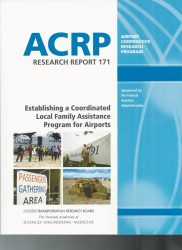Crisis response: Equipping airports with the tools to meet human needs
- Like
- Digg
- Del
- Tumblr
- VKontakte
- Buffer
- Love This
- Odnoklassniki
- Meneame
- Blogger
- Amazon
- Yahoo Mail
- Gmail
- AOL
- Newsvine
- HackerNews
- Evernote
- MySpace
- Mail.ru
- Viadeo
- Line
- Comments
- Yummly
- SMS
- Viber
- Telegram
- Subscribe
- Skype
- Facebook Messenger
- Kakao
- LiveJournal
- Yammer
- Edgar
- Fintel
- Mix
- Instapaper
- Copy Link
Posted: 28 June 2017 | Jennifer Stansberry Miller, Ken Jenkins, Sue Warner-Bean | No comments yet
ACRP guidebook outlines best practices for airports in responding to individuals following an aviation disaster or critical incident.


In the aftermath of an aviation disaster or critical incident, airports are often the first point of contact for affected passengers, friends and relatives. Yet guidance for airports is notably absent from international aviation disaster laws and policies. A newly-published guidebook, based on extensive research, aims to address this gap and equip airports with practical tools to meet critical human needs following a disaster.
Over two decades ago the first aviation disaster family assistance law (the United States Aviation Disaster Family Assistance Act of 1996) was created through the collaborative efforts of a multi-disciplinary team of stakeholders. Prompted by the advocacy efforts of victims’ families and passenger survivors, their shared objective was to design a “blueprint for the proper treatment of families by all those involved following an aviation disaster.”1 That “blueprint” became the foundation for a global movement, growing from laws in a handful of countries to an international standard: International Civil Aviation Organisation (ICAO) Policy Document 9998 AN/499, ICAO Policy on Assistance to Aircraft Accident Victims and their Families.
These laws and policies have significantly improved the standard of care provided to affected passengers, friends and relatives by prescribing roles for government, non-governmental organisations, and airlines. The role of airports, however, has remained undefined.
The role of airports, however, has remained undefined.
The need for research-based best practices in airport family assistance was identified by Transportation Research Board’s Airport Cooperative Research Program (ACRP), a division of the U.S. National Academies of Sciences, Engineering and Medicine, and became the basis for a new publication: ACRP Research Report 171: Establishing a Coordinated Local Family Assistance Program for Airports. The materials, which include a guidebook and extensive “toolkit” of practical resources, are available for free download at the Transportation Research Board’s website:
Research Report 171: Establishing a Coordinated Local Family Assistance Program for Airports, was sponsored by the U.S. Federal Aviation Administration (FAA) and is designed for use by airports of any size. While targeting a U.S. audience, the standards and best practices, much like family assistance law, can be adapted for international use. The report is based on interviews with twenty-seven U.S. airports, eleven airlines, and outreach to twenty-eight aviation disaster family associations worldwide.
In identifying best practices, the guidebook addresses the four phases of emergency management: mitigation, preparedness, response, and recovery. It provides insight on strategic planning and addresses the roles and responsibilities of responding organisations during each phase of response. Particular emphasis is placed on the incident response phase (0-24 hours), the window during which airline corporate response teams may still be en route and the response will be largely up to airport and local staff. A process overview is presented in a simple graphic illustration (see figure 1).


Figure 1: Passenger and Family Assistance Initial Response Flow. Warner-Bean, S Jenkins, K; Stansberry Miller, J; Parkins C; and Hoaglund R, ACRP Research Report 171: Establishing a Coordinated Local Family Assistance Program for Airports, Airport Cooperative Research Program; Transportation Research Board; National Academies of Sciences, Engineering, and Medicine Courtesy, 2017 p. 31.
In the initial hours following an aviation disaster or critical incident, research showed that airports often experience an influx of individuals seeking information about loved ones. Yet information is often very limited, and the airport is operating under the increased pressures of disrupted operations, heightened passenger anxiety, and intense media scrutiny. In an environment where “virtual airlines” with contracted ground handling staff have become more the norm, addressing families’ and survivors’ needs in the initial post-incident hours has become even more complex.
In the initial hours following an aviation disaster or critical incident, research showed that airports often experience an influx of individuals seeking information about loved ones.
Research from the airports concluded there is a vested interest in supporting the affected passengers and families, even when capabilities are limited. As one airport respondent stated, “If you are not prepared to deal with the friends and family of accident victims in a disaster situation, you’re overlooking a very real and critical component in your emergency response.” Unfortunately, airports often lack the assets and resources to create such a dynamic program. This underscores the need for a coordinated, multi-stakeholder response.
To address the lack of local airport resources, several airports reported success in developing emergency response working groups and volunteer incident response teams. Emergency response working groups develop mutual aid strategies; this might include communication protocols, standardised forms, and a unified approach to coordination with the Emergency Operations Centre.
Working groups are typically composed of representatives from the airport, airlines, and key responding agencies (disaster mental health services, hospitals, and others). Volunteer incident response teams address staffing needs; they might include airport, airline and community members. Volunteers are trained to provide direct assistance to affected families and survivors at the airport until other support services are in place.
The overwhelming concern noted by family members interviewed was the lack of information provided by airports and airlines in the initial hours after a disaster. In the words of one respondent, “Nothing can change what happened, but I think it might have been helpful when we got to the airport if we had been received by personnel who were better informed of the facts and the circumstances, by personnel who were kept constantly up-to-date, as much as possible, on the developments in the situation.”
The guidebook addresses communications from two standpoints. First, it provides guidance on communicating with internal and external stakeholders, the media, and the general public. Second, it offers specific considerations in communicating directly with affected families, friends and survivors. The accompanying toolkit include a free training course on communicating with affected individuals, designed for use as either a self-paced online course or a facilitator-led classroom training. The toolkit also provides guidance materials and sample scripts to help airports and airlines deliver briefings to families and survivors.
The guidebook presents best practices for transitioning to an offsite family assistance centre
Detailed guidance on implementing a family assistance program is included in the Operations and Logistics section of the guidebook. It delves into the specifics of when and how to activate a family assistance program, the victim accounting process, security needs, facility recommendations, and practical considerations ranging from room supplies to parking control to volunteer management. Focus areas include the Friends and Relatives Centre (FRC) where loved ones gather for information, the Passenger Gathering Area (for uninjured survivors), and the Reunification Location.
Research underscored the fact that family assistance extends beyond the initial response and can impact airports for months and even years after the incident. The guidebook presents best practices for transitioning to an offsite family assistance centre and for addressing site visits, monuments, and anniversaries. It also offers strategies for responder well-being and resilience, to support airport staff affected by the event.
Five case studies are included in the guidebook, each examining a different accident, the airport’s family assistance response, and lessons learned. Case studies were selected to represent a broad spectrum of response considerations. They include all-survivor and all-fatal disasters, incidents occurring on and off airport property, and events with ground casualties. Airports interviewed for case studies range from an accident at a large hub airport involving an international flight, to a general aviation accident at a small airport with one full-time employee.
Finally, the guidebook is accompanied by a toolkit that includes customisation checklists and forms, training courses, and exercise materials that airports can use as-is or adapt to their operating environment. All materials are designed to be practical, relevant, and adaptable.
The research team for ACRP Research Report included co-authors Sue Warner-Bean, Ken Jenkins, and Jennifer Stansberry Miller (all of NavAid Crisis Consulting Group), and contributing authors Christina Parkins (TetraTech), and Rick Hoagland (an independent consultant). Oversight of the two-year project was provided by a multidisciplinary panel of subject matter experts representing airports, airlines, service providers, the FAA, and the U.S. National Transportation Board’s (NTSB) Transportation Disaster Assistance Division.


While no two aviation disasters or critical incidents are alike, the need for family assistance is universal. Governments, airlines, and non-governmental agencies have had clear and specific guidance in aviation disaster family assistance for more than two decades. Airports have not. With the publication of ACRP Research Report 171, the foundation for a new international standard for airports – and a consistent standard of care for passenger survivors, friends and relatives they serve – is finally in place.
Sue Warner-Bean, Ken Jenkins, and Jennifer Stansberry Miller are Principals and Crisis Strategists at NavAid Crisis Consulting Group, partnering with clients to design customised response programs prioritizing human needs. They serve airports, airlines, and more.
1 Final Report of the United States Department of Transportation/National Transportation Safety Board Task Force on Assistance to Families of Aviation Disasters, October 29, 1997
Related topics
Accidents and incidents, Airport crisis management, Terrorist attacks
















